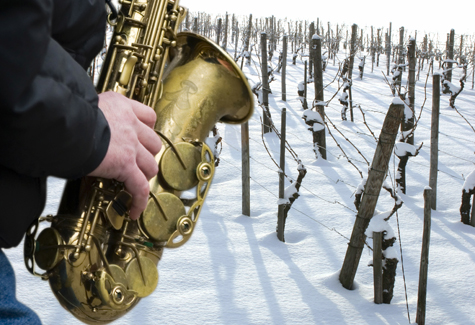Winterfest 2011: What is Jazz?

Editor’s Note: Winterfest 2011 kicks off Friday night at Hilton Garden Inn in Riverhead with the Winterfest Warm-Up and continues for six weeks at vineyards across the North Fork. The following essay was excerpted from our Winterfest guide.
From the listener’s perspective, in 500 words or less, how does one start to break down the identifying features and more than 120 years of history to describe what makes jazz, jazz? Is there a silver bullet that tells us how, or why, or what to listen for?
Well, actually, not specifically, and yes.
Born in New Orleans in the early 1900s, and later through Chicago to New York via Louis Armstrong, the building blocks of jazz have always been linked to the founding principles of America: individuality and liberty.
As the center of society in African cultures, the drum and its rhythms represented identity and communication for African slaves. In America, the rhythmic use of European brass and woodwind instruments, combined with Jelly Roll Morton and Scott Joplin’s “Ragged Time” approach on the piano, became the means of “singing” with an individual, yet stylized voice. It was about the rhythm, yes, and it was also about the inflection and the mood.
Building upon spirituals and work songs that inspired the blues, jazz music grew to become a means of expressing improvised versions of popular songs, maintaining the basic structure, but varying the melody. George Gershwin’s “I Got Rhythm,” for example, was rewritten by Lester Young as “Lester Leaps In,” by Charlie Parker as “Moose the Mooch,” and by Duke Ellington as “Cottontail.”
Imagine, for a moment, some simple nursery rhymes and well-known songs. “Twinkle Twinkle Little Star” and the alphabet song “A-B-C-D-E-F-G,” for example, are really the same tune with different words. Think about it.
“Happy Birthday” and “The Star Spangled Banner” begin as identical rhythms, but they are clearly different tunes. Right?
Jazz musicians not only change the words and the tunes in their performances, they also change the rhythm — and the more unique they are, the more successful the improvisation. But the spontaneous interplay also needs to make sense. The players need to be listening, interacting and speaking in the same language and accent.
Just as spoken English — in England, Texas or Brooklyn — is still the English language, the styles of jazz and the evolution of the music continue to represent geographic and cultural identities. The Swing Era dance bands of the 1940s inspired adventurous musicians to create be-bop in the after-hours clubs. 1950s “cool jazz” and “hard bop” were countered by “modal” and “free jazz” in the 1960s. Jazz/rock/fusion and “California smooth jazz” spun off from the downtown and uptown scenes in New York, not to mention Latin, European and “third stream” movements. And all the way through was the rhythm, the notion that “It Don’t Mean A Thing, If It Ain’t Got That Swing.”
So, underlying all of these developments and interpretations of the great art form known as Jazz, we find three principles. One: Borrow from the past and respect where you came from. Two: Be yourself and tell your own story. Three: Pay attention to the world around you, and stretch the limits of your imagination.
OK, in 500 words, that’s a start.


